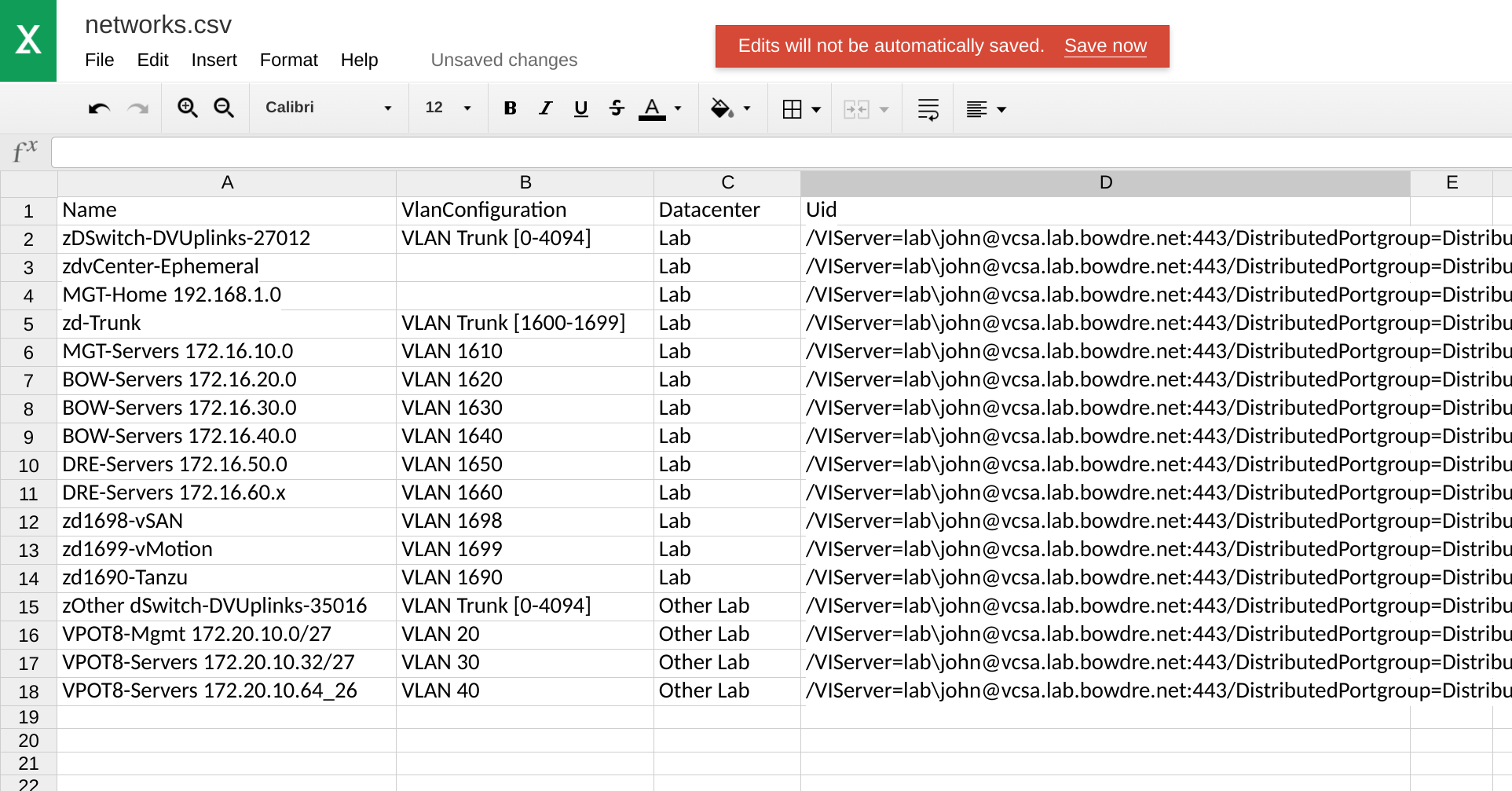21 KiB
| title | date | description | featured | draft | toc | usePageBundles | codeLineNumbers | series | tags | comment | |||||
|---|---|---|---|---|---|---|---|---|---|---|---|---|---|---|---|
| Bulk Import vSphere dvPortGroups to phpIPAM | 2022-01-21T15:24:00-06:00 | I wrote a Python script to interface with the phpIPAM API and import a large number of networks exported from vSphere for IP management. | false | true | false | true | false | Scripts |
|
true |
I recently wrote about getting started with VMware's Tanzu Community Edition and deploying phpIPAM as my first real-world Kubernetes workload. Well I've spent much of my time since then working on a script which would help to populate my phpIPAM instance with a list of networks to monitor.
Planning and Exporting
The first step in making this work was to figure out which networks I wanted to import. We've got hundreds of different networks in use across our production vSphere environments. I focused only on those which are portgroups on distributed virtual switches since those configurations are pretty standardized (being vCenter constructs instead of configured on individual hosts). These dvPortGroups bear a naming standard which conveys all sorts of useful information, and it's easy and safe to rename any dvPortGroups which don't fit the standard (unlike renaming portgroups on a standard virtual switch).
The standard naming convention is [Site/Description] [Network Address]{/[Mask]}. So the networks (across two virtual datacenters and two dvSwitches) look something like this:
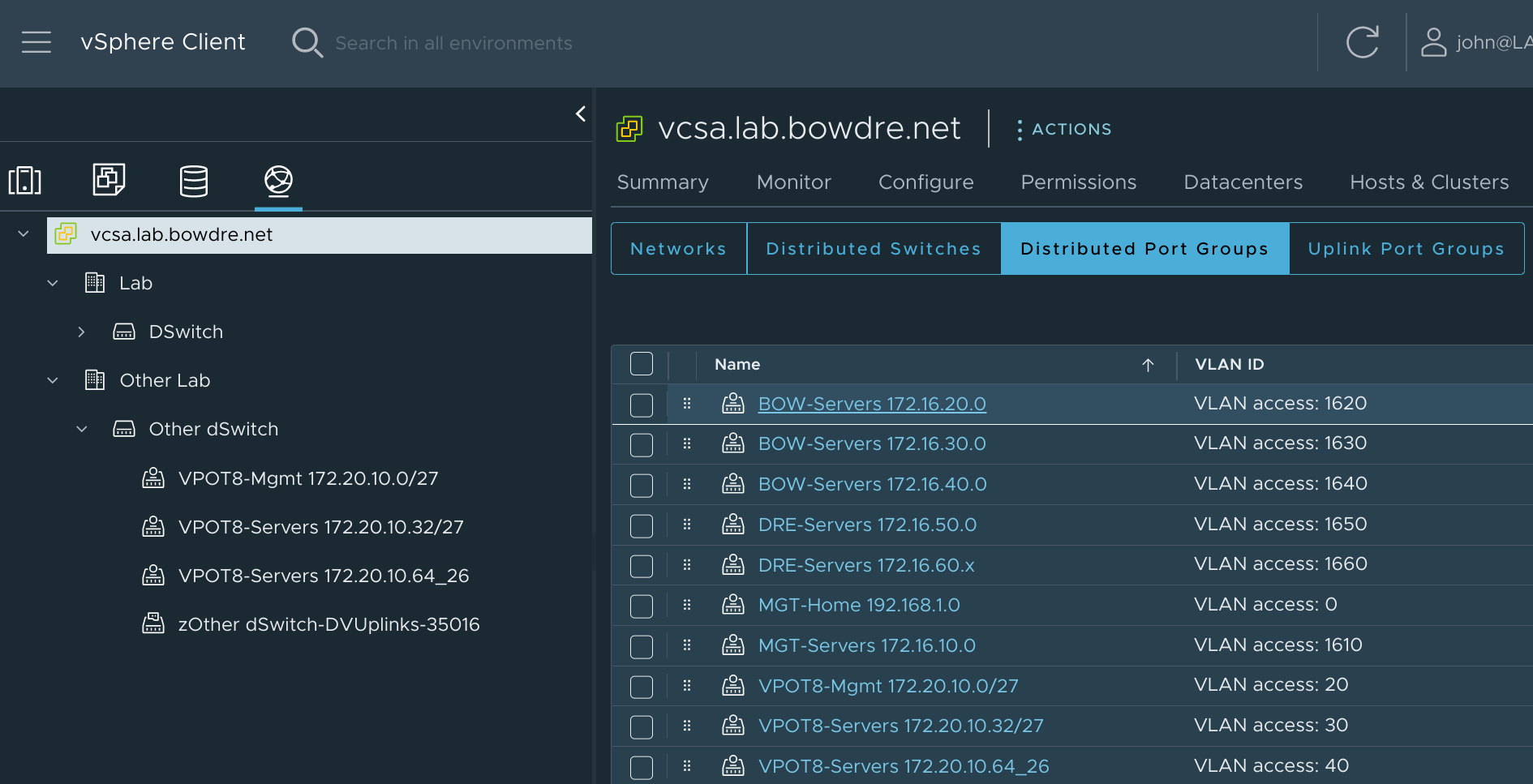
Some networks have masks in the name, some don't; and some use an underscore (_) rather than a slash (/) to separate the network from the mask . Most networks correctly include the network address with a 0 in the last octet, but some use an x instead. And the VLANs associated with the networks have a varying number of digits. Consistency can be difficult so these are all things that I had to keep in mind as I worked on a solution which would make a true best effort at importing all of these.
As long as the dvPortGroup names stick to this format I can parse the name to come up with a description as well as the IP space of the network. The dvPortGroup also carries information about the associated VLAN, which is useful information to have. And I can easily export this information with a simple PowerCLI query:
PS /home/john> get-vdportgroup | select Name, VlanConfiguration
Name VlanConfiguration
---- -----------------
MGT-Home 192.168.1.0
MGT-Servers 172.16.10.0 VLAN 1610
BOW-Servers 172.16.20.0 VLAN 1620
BOW-Servers 172.16.30.0 VLAN 1630
BOW-Servers 172.16.40.0 VLAN 1640
DRE-Servers 172.16.50.0 VLAN 1650
DRE-Servers 172.16.60.x VLAN 1660
VPOT8-Mgmt 172.20.10.0/27 VLAN 20
VPOT8-Servers 172.20.10.32/27 VLAN 30
VPOT8-Servers 172.20.10.64_26 VLAN 40
In my homelab, I only have a single vCenter. In production, we've got a handful of vCenters, and each manages the hosts in a given region. So I can use information about which vCenter hosts a dvPortGroup to figure out which region a network is in. When I import this data into phpIPAM, I can use the vCenter name to assign remote scan agents to networks based on the region that they're in. I can also grab information about which virtual datacenter a dvPortGroup lives in, which I'll use for grouping networks into sites or sections.
The vCenter can be found in the Uid property returned by get-vdportgroup:
PS /home/john> get-vdportgroup | select Name, VlanConfiguration, Datacenter, Uid
Name VlanConfiguration Datacenter Uid
---- ----------------- ---------- ---
MGT-Home 192.168.1.0 Lab /VIServer=lab\john@vcsa.lab.bowdre.net:443/DistributedPortgroup=DistributedVirtualPortgroup-dvportgroup-27015/
MGT-Servers 172.16.10.0 VLAN 1610 Lab /VIServer=lab\john@vcsa.lab.bowdre.net:443/DistributedPortgroup=DistributedVirtualPortgroup-dvportgroup-27017/
BOW-Servers 172.16.20.0 VLAN 1620 Lab /VIServer=lab\john@vcsa.lab.bowdre.net:443/DistributedPortgroup=DistributedVirtualPortgroup-dvportgroup-28010/
BOW-Servers 172.16.30.0 VLAN 1630 Lab /VIServer=lab\john@vcsa.lab.bowdre.net:443/DistributedPortgroup=DistributedVirtualPortgroup-dvportgroup-28011/
BOW-Servers 172.16.40.0 VLAN 1640 Lab /VIServer=lab\john@vcsa.lab.bowdre.net:443/DistributedPortgroup=DistributedVirtualPortgroup-dvportgroup-28012/
DRE-Servers 172.16.50.0 VLAN 1650 Lab /VIServer=lab\john@vcsa.lab.bowdre.net:443/DistributedPortgroup=DistributedVirtualPortgroup-dvportgroup-28013/
DRE-Servers 172.16.60.x VLAN 1660 Lab /VIServer=lab\john@vcsa.lab.bowdre.net:443/DistributedPortgroup=DistributedVirtualPortgroup-dvportgroup-28014/
VPOT8-Mgmt 172.20.10.0/… VLAN 20 Other Lab /VIServer=lab\john@vcsa.lab.bowdre.net:443/DistributedPortgroup=DistributedVirtualPortgroup-dvportgroup-35018/
VPOT8-Servers 172.20.10… VLAN 30 Other Lab /VIServer=lab\john@vcsa.lab.bowdre.net:443/DistributedPortgroup=DistributedVirtualPortgroup-dvportgroup-35019/
VPOT8-Servers 172.20.10… VLAN 40 Other Lab /VIServer=lab\john@vcsa.lab.bowdre.net:443/DistributedPortgroup=DistributedVirtualPortgroup-dvportgroup-35020/
It's not pretty, but it'll do the trick. All that's left is to export this data into a handy-dandy CSV-formatted file that I can easily parse for import:
get-vdportgroup | select Name, VlanConfiguration, Datacenter, Uid | export-csv -NoTypeInformation ./networks.csv
Setting up phpIPAM
After deploying a fresh phpIPAM instance on my Tanzu Community Edition Kubernetes cluster, there are a few additional steps needed to enable API access. To start, I log in to my phpIPAM instance and navigate to the Administration > Server Management > phpIPAM Settings page, where I enabled both the Prettify links and API feature settings - making sure to hit the Save button at the bottom of the page once I do so.
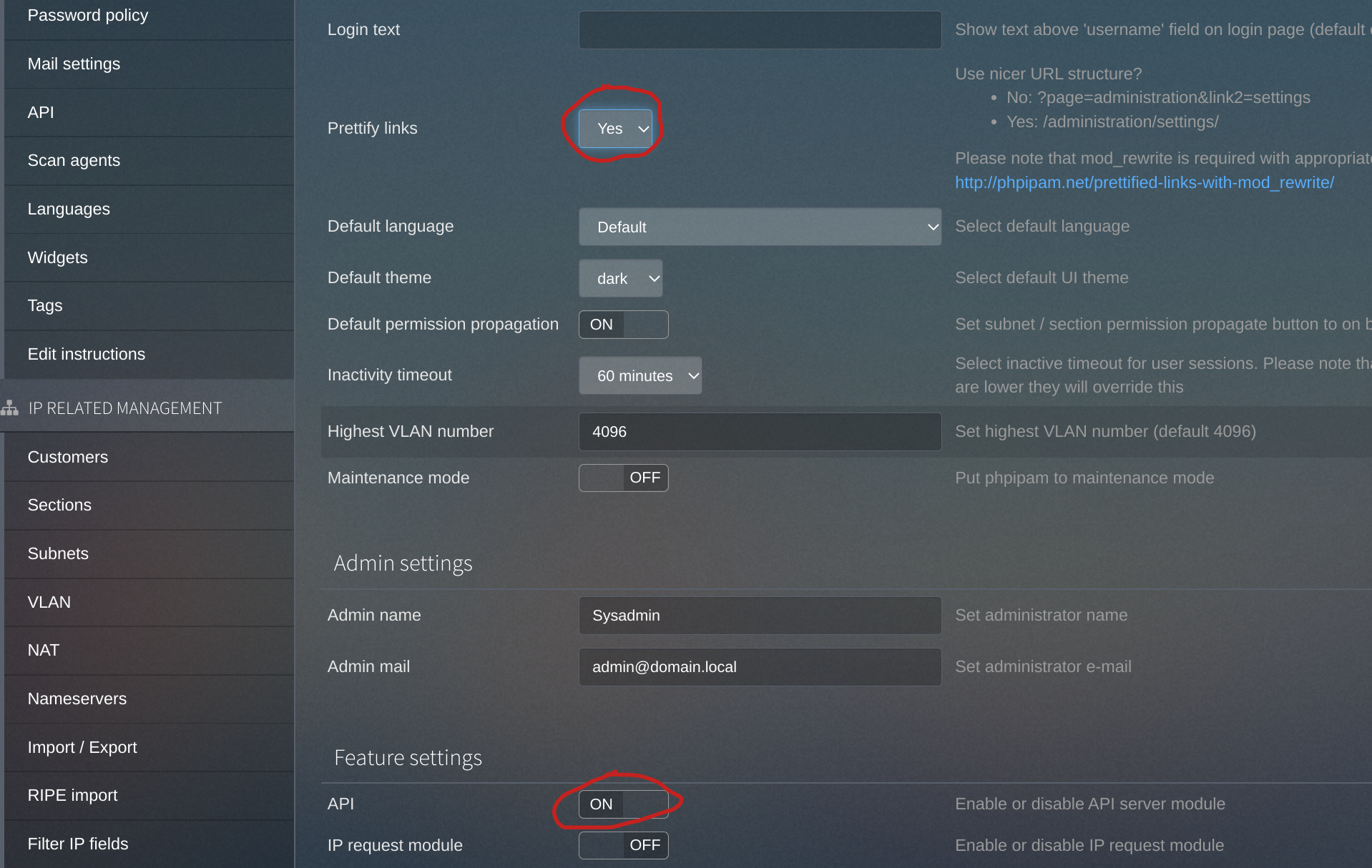
Then I need to head to the User Management page to create a new user that will be used to authenticate against the API:
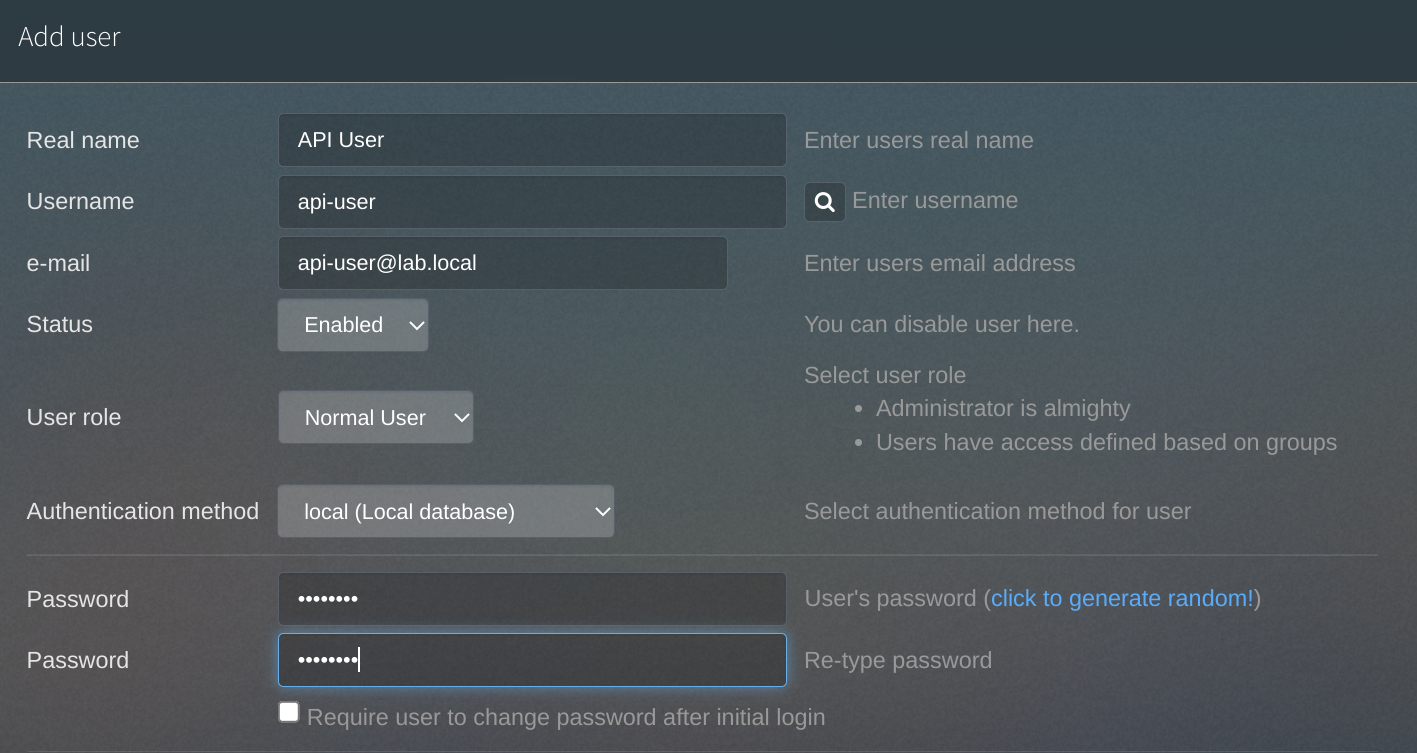
And finally, I head to the API section to create a new API key with Read/Write permissions:

I'm also going to head in to Administration > IP Related Management > Sections and delete the default sample sections so that the inventory will be nice and empty:
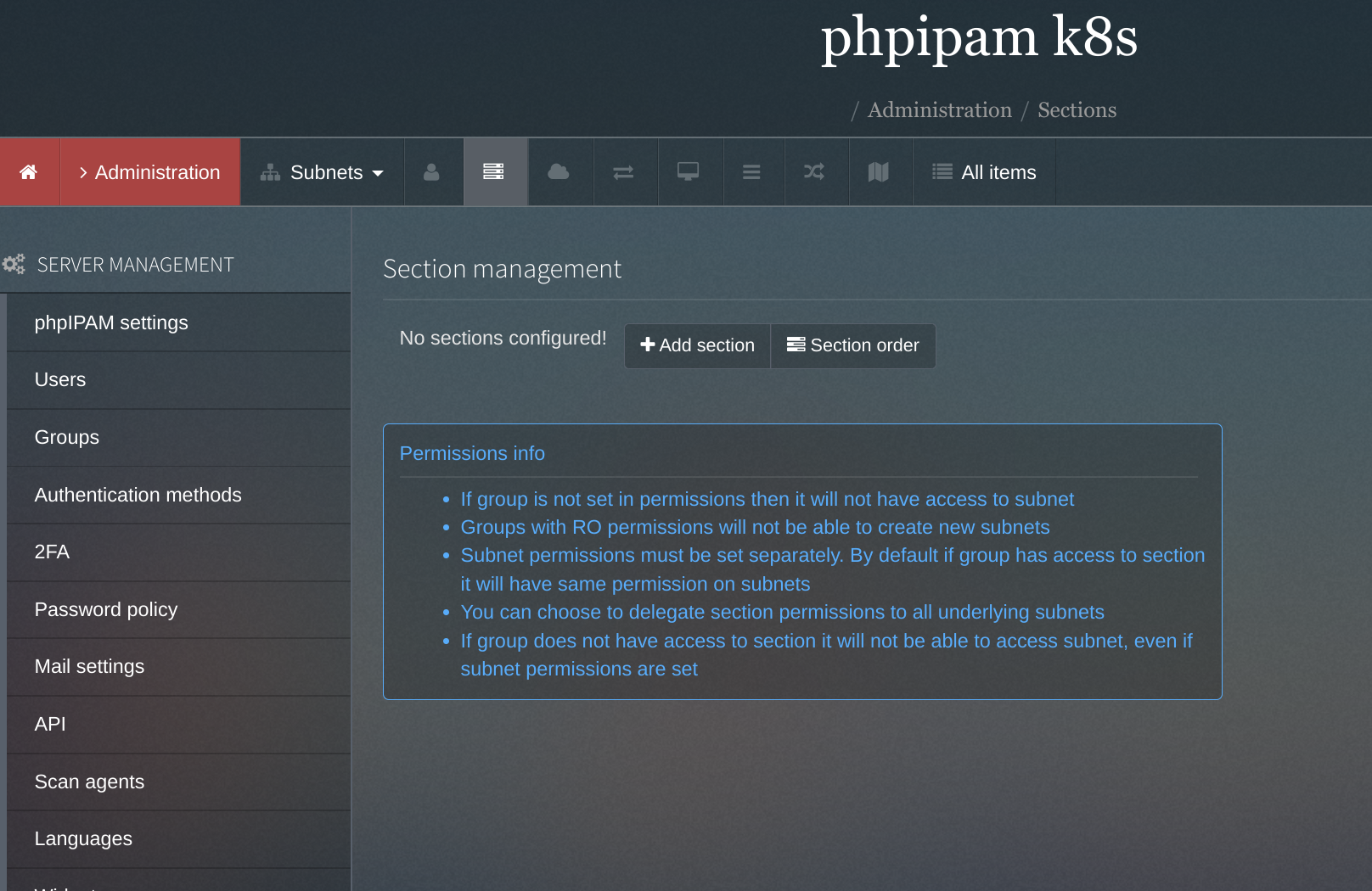
Script time
Well that's enough prep work; now it's time for the script. It's going to start by prompting the user to input required details like the fully-qualified host name of the phpIPAM server, the credentials and API key to use for the connection, and the CSV file from which to import the networks.
Notice that the script also prompts for a default set of DNS nameservers to be used. It will create a nameserver set in phpIPAM for each region (based on the vCenter) using these IPs.
# The latest version of this script can be found on Github:
# https://github.com/jbowdre/misc-scripts/blob/main/Python/phpipam-bulk-import.py
"""
This interactive script helps to import vSphere dvPortGroup networks into phpIPAM for monitoring IP usage.
It is assumed that the dvPortGroups are named like '[Description] [Network address]{/[mask]}':
Ex:
LAB-Management 192.168.1.0
BOW-Servers 172.16.10.0/26
Networks can be exported from vSphere via PowerCLI:
Get-VDPortgroup | Select Name, Datacenter, VlanConfiguration, Uid | Export-Csv -NoTypeInformation ./networks.csv
Subnets added to phpIPAM will be automatically configured for monitoring either using the built-in scan agent (default)
or a new remote scan agent named for the source vCenter ('vcenter_name-agent').
"""
import requests
from collections import namedtuple
check_cert = True
created = 0
remote_agent = False
name_to_id = namedtuple('name_to_id', ['name', 'id'])
#for testing only
# from requests.packages.urllib3.exceptions import InsecureRequestWarning
# requests.packages.urllib3.disable_warnings(InsecureRequestWarning)
# check_cert = False
def validate_input_is_not_empty(field, prompt):
while True:
user_input = input(f'\n{prompt}:\n')
if len(user_input) == 0:
print(f'[ERROR] {field} cannot be empty!')
continue
else:
return user_input
def get_sorted_list_of_unique_values(key, list_of_dict):
valueSet = set(sub[key] for sub in list_of_dict)
valueList = list(valueSet)
valueList.sort()
return valueList
def get_id_from_sets(name, sets):
return [item.id for item in sets if name == item.name][0]
def auth_session(uri, auth):
# authenticate to the API endpoint and retrieve an auth token
print(f'Authenticating to {uri}...')
try:
req = requests.post(f'{uri}/user/', auth=auth, verify=check_cert)
except:
raise requests.exceptions.RequestException
if req.status_code != 200:
print(f'[ERROR] Authentication failure: {req.json()}')
raise requests.exceptions.RequestException
token = {"token": req.json()['data']['token']}
print('\n[AUTH_SUCCESS] Authenticated successfully!')
return token
def get_agent_sets(uri, token, regions):
agent_sets = []
def create_agent_set(uri, token, name):
import secrets
payload = {
'name': name,
'type': 'mysql',
'code': secrets.base64.urlsafe_b64encode(secrets.token_bytes(24)).decode("utf-8"),
'description': f'Remote scan agent for region {name}'
}
req = requests.post(f'{uri}/tools/scanagents/', data=payload, headers=token, verify=check_cert)
id = req.json()['id']
agent_set = name_to_id(name, id)
print(f'[AGENT_CREATE] {name} created.')
return agent_set
for region in regions:
name = regions[region]['name']
req = requests.get(f'{uri}/tools/scanagents/?filter_by=name&filter_value={name}', headers=token, verify=check_cert)
if req.status_code == 200:
id = req.json()['data'][0]['id']
agent_set = name_to_id(name, id)
else:
agent_set = create_agent_set(uri, token, name)
agent_sets.append(agent_set)
return agent_sets
def get_section(uri, token, section, parentSectionId):
def create_section(uri, token, section, parentSectionId):
payload = {
'name': section,
'masterSection': parentSectionId,
'permissions': '{"2":"2"}',
'showVLAN': '1'
}
req = requests.post(f'{uri}/sections/', data=payload, headers=token, verify=check_cert)
id = req.json()['id']
print(f'[SECTION_CREATE] Section {section} created.')
return id
req = requests.get(f'{uri}/sections/{section}/', headers=token, verify=check_cert)
if req.status_code == 200:
id = req.json()['data']['id']
else:
id = create_section(uri, token, section, parentSectionId)
return id
def get_vlan_sets(uri, token, vlans):
vlan_sets = []
def create_vlan_set(uri, token, vlan):
payload = {
'name': f'VLAN {vlan}',
'number': vlan
}
req = requests.post(f'{uri}/vlan/', data=payload, headers=token, verify=check_cert)
id = req.json()['id']
vlan_set = name_to_id(vlan, id)
print(f'[VLAN_CREATE] VLAN {vlan} created.')
return vlan_set
for vlan in vlans:
if vlan != 0:
req = requests.get(f'{uri}/vlan/?filter_by=number&filter_value={vlan}', headers=token, verify=check_cert)
if req.status_code == 200:
id = req.json()['data'][0]['vlanId']
vlan_set = name_to_id(vlan, id)
else:
vlan_set = create_vlan_set(uri, token, vlan)
vlan_sets.append(vlan_set)
return vlan_sets
def get_nameserver_sets(uri, token, regions):
nameserver_sets = []
def create_nameserver_set(uri, token, name, nameservers):
payload = {
'name': name,
'namesrv1': nameservers,
'description': f'Nameserver created for region {name}'
}
req = requests.post(f'{uri}/tools/nameservers/', data=payload, headers=token, verify=check_cert)
id = req.json()['id']
nameserver_set = name_to_id(name, id)
print(f'[NAMESERVER_CREATE] Nameserver {name} created.')
return nameserver_set
for region in regions:
name = regions[region]['name']
req = requests.get(f'{uri}/tools/nameservers/?filter_by=name&filter_value={name}', headers=token, verify=check_cert)
if req.status_code == 200:
id = req.json()['data'][0]['id']
nameserver_set = name_to_id(name, id)
else:
nameserver_set = create_nameserver_set(uri, token, name, regions[region]['nameservers'])
nameserver_sets.append(nameserver_set)
return nameserver_sets
def create_subnet(uri, token, network):
def update_nameserver_permissions(uri, token, network):
nameserverId = network['nameserverId']
sectionId = network['sectionId']
req = requests.get(f'{uri}/tools/nameservers/{nameserverId}/', headers=token, verify=check_cert)
permissions = req.json()['data']['permissions']
permissions = str(permissions).split(';')
if not sectionId in permissions:
permissions.append(sectionId)
if 'None' in permissions:
permissions.remove('None')
permissions = ';'.join(permissions)
payload = {
'permissions': permissions
}
req = requests.patch(f'{uri}/tools/nameservers/{nameserverId}/', data=payload, headers=token, verify=check_cert)
payload = {
'subnet': network['subnet'],
'mask': network['mask'],
'description': network['name'],
'sectionId': network['sectionId'],
'scanAgent': network['agentId'],
'nameserverId': network['nameserverId'],
'vlanId': network['vlanId'],
'pingSubnet': '1',
'discoverSubnet': '1',
'resolveDNS': '1',
'DNSrecords': '1'
}
req = requests.post(f'{uri}/subnets/', data=payload, headers=token, verify=check_cert)
if req.status_code == 201:
network['subnetId'] = req.json()['id']
update_nameserver_permissions(uri, token, network)
print(f"[SUBNET_CREATE] Created subnet {req.json()['data']}")
global created
created += 1
elif req.status_code == 409:
print(f"[SUBNET_EXISTS] Subnet {network['subnet']}/{network['mask']} already exists.")
else:
print(f"[ERROR] Problem creating subnet {network['name']}: {req.json()}")
def import_networks(filepath):
# import the list of networks from the specified csv file
print(f'Importing networks from {filepath}...')
import csv
import re
ipPattern = re.compile('\d{1,3}\.\d{1,3}\.\d{1,3}\.[0-9xX]{1,3}')
networks = []
with open(filepath) as csv_file:
reader = csv.DictReader(csv_file)
line_count = 0
for row in reader:
network = {}
if line_count > 0:
if(re.search(ipPattern, row['Name'])):
network['subnet'] = re.findall(ipPattern, row['Name'])[0]
if network['subnet'].split('.')[-1].lower() == 'x':
network['subnet'] = network['subnet'].lower().replace('x', '0')
network['name'] = row['Name']
if '/' in row['Name'][-3]:
network['mask'] = row['Name'].split('/')[-1]
else:
network['mask'] = '24'
network['section'] = row['Datacenter']
try:
network['vlan'] = int(row['VlanConfiguration'].split('VLAN ')[1])
except:
network['vlan'] = 0
network['vcenter'] = f"{(row['Uid'].split('@'))[1].split(':')[0].split('.')[0]}"
networks.append(network)
line_count += 1
print(f'Processed {line_count} lines and found:')
return networks
def main():
# gather inputs
import socket
import getpass
import argparse
from pathlib import Path
parser = argparse.ArgumentParser()
parser.add_argument("filepath", type=Path)
print("""\n\n
This script helps to add vSphere networks to phpIPAM for IP address management. It is expected
that the vSphere networks are configured as portgroups on distributed virtual switches and
named like '[Site]-[Purpose] [Subnet IP]{/[mask]}' (ex: 'LAB-Servers 192.168.1.0'). The following PowerCLI
command can be used to export the networks from vSphere:
Get-VDPortgroup | Select Name, Datacenter, VlanConfiguration, Uid | Export-Csv -NoTypeInformation ./networks.csv
Subnets added to phpIPAM will be automatically configured for monitoring either using the built-in
scan agent (default) or a new remote scan agent named for the source vCenter ('vcenter_name-agent').
""")
try:
p = parser.parse_args()
filepath = p.filepath
except:
# make sure filepath is a path to an actual file
while True:
filepath = Path(validate_input_is_not_empty('Filepath', 'Path to CSV-formatted export from vCenter'))
if filepath.exists():
break
else:
print(f'[ERROR] Unable to find file at {filepath.name}.')
continue
# get collection of networks to import
networks = import_networks(filepath)
networkNames = get_sorted_list_of_unique_values('name', networks)
print(f'\n- {len(networkNames)} networks:\n\t{networkNames}')
vcenters = get_sorted_list_of_unique_values('vcenter', networks)
print(f'\n- {len(vcenters)} vCenter servers:\n\t{vcenters}')
vlans = get_sorted_list_of_unique_values('vlan', networks)
print(f'\n- {len(vlans)} VLANs:\n\t{vlans}')
sections = get_sorted_list_of_unique_values('section', networks)
print(f'\n- {len(sections)} Datacenters:\n\t{sections}')
regions = {}
for vcenter in vcenters:
nameservers = None
name = validate_input_is_not_empty('Region Name', f'Region name for vCenter {vcenter}')
for region in regions:
if name in regions[region]['name']:
nameservers = regions[region]['nameservers']
if not nameservers:
nameservers = validate_input_is_not_empty('Nameserver IPs', f"Comma-separated list of nameserver IPs in {name}")
nameservers = nameservers.replace(',',';').replace(' ','')
regions[vcenter] = {'name': name, 'nameservers': nameservers}
# make sure hostname resolves
while True:
hostname = input('\nFully-qualified domain name of the phpIPAM host:\n')
if len(hostname) == 0:
print('[ERROR] Hostname cannot be empty.')
continue
try:
test = socket.gethostbyname(hostname)
except:
print(f'[ERROR] Unable to resolve {hostname}.')
continue
else:
del test
break
username = validate_input_is_not_empty('Username', f'Username with read/write access to {hostname}')
password = getpass.getpass(f'Password for {username}:\n')
apiAppId = validate_input_is_not_empty('App ID', f'App ID for API key (from https://{hostname}/administration/api/)')
agent = input('\nUse per-region remote scan agents instead of a single local scanner? (y/N):\n')
try:
if agent.lower()[0] == 'y':
global remote_agent
remote_agent = True
except:
pass
proceed = input(f'\n\nProceed with importing {len(networkNames)} networks to {hostname}? (y/N):\n')
try:
if proceed.lower()[0] == 'y':
pass
else:
import sys
sys.exit("Operation aborted.")
except:
import sys
sys.exit("Operation aborted.")
del proceed
# assemble variables
uri = f'https://{hostname}/api/{apiAppId}'
auth = (username, password)
# auth to phpIPAM
token = auth_session(uri, auth)
nameserver_sets = get_nameserver_sets(uri, token, regions)
vlan_sets = get_vlan_sets(uri, token, vlans)
if remote_agent:
agent_sets = get_agent_sets(uri, token, regions)
# create the networks
for network in networks:
network['region'] = regions[network['vcenter']]['name']
network['regionId'] = get_section(uri, token, network['region'], None)
network['nameserverId'] = get_id_from_sets(network['region'], nameserver_sets)
network['sectionId'] = get_section(uri, token, network['section'], network['regionId'])
if network['vlan'] == 0:
network['vlanId'] = None
else:
network['vlanId'] = get_id_from_sets(network['vlan'], vlan_sets)
if remote_agent:
network['agentId'] = get_id_from_sets(network['region'], agent_sets)
else:
network['agentId'] = '1'
create_subnet(uri, token, network)
print(f'\n[FINISH] Created {created} of {len(networks)} networks.')
if __name__ == "__main__":
main()
